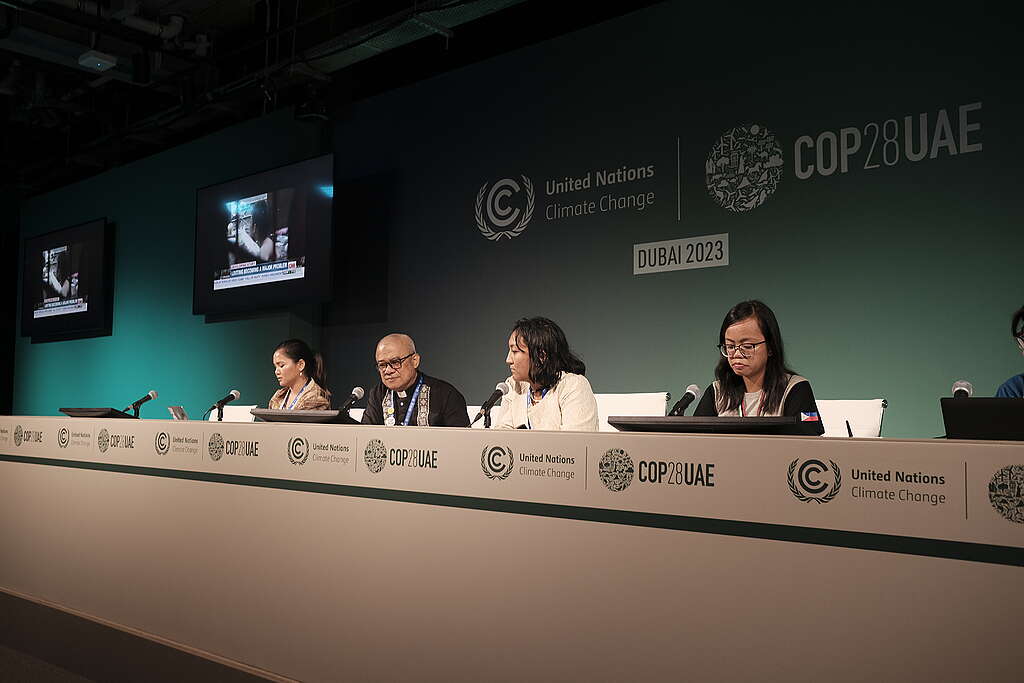Calls on world leaders to ‘make polluters pay’ for climate crisis

Dubai, UAE, 9 December 2023 – Civil society delegates from the Philippines today launched the “People’s Museum of Climate Justice” at a side event in COP 28 in Dubai. The museum is a living exhibit that features the heroism, aspirations and struggles of climate impacted communities—as well as their demand for governments to make polluters pay for losses and damages they experience daily.
The museum, mounted by Aksyon Klima Pilipinas, Greenpeace Philippines, Living Laudato Si’ Philippines and Manila Observatory in the Blue Zone (SE Room 1) seeks to show how communities around the world are standing up and demanding action to attain climate justice. It was first launched in Tacloban City, Philippines on November 6 to commemorate the 10th year anniversary of Super Typhoon Haiyan.[1] The museum became an essential part of the Greenpeace Rainbow Warrior visit to the Philippines in November to honor impacted communities demanding corporate climate accountability and reparations for loss and damage. The virtual museum features stories from Canada, Vanuatu, China, Philippines, Indonesia, UAE, Nigeria, Egypt, and other parts of the world.
“In taking action to solve the climate crisis, we must not forget the wrongs of the past which resulted in massive losses and damages. We remember and, in our consciousness, lives, livelihoods, and opportunities lost become realities which prompted parties to establish the loss and damage mechanism, said Rodne Galicha, National Convenor of Aksyon Klima Pilipinas. “In remembering, we give respect and we learn to stand up. While the operationalization of the loss and damage fund and its financial arrangements have been agreed upon, it is apathetic that some of those who pledge do not recognize climate accountability–as if the fund is a privilege and favor–which is far from the context of climate justice. May COP28 be a COP of conscience, of compassion; not of shows, nuances, and powerplay,” he added.
“We co-created the People’s Museum of Climate Justice together with communities as a means to reclaim our histories, livelihoods, nature, and culture, which are being lost due to the climate crisis,” said Virginia Benosa-Llorin, Co-lead of the Make Polluters Pay campaign of Greenpeace. “The museum showcases the strength of communities impacted by the climate crisis. Alongside memorializing the profound impacts of climate change on communities, the stories also reflect how communities globally have had enough and are standing up to the fossil fuel industry that is exacerbating this crisis,” Llorin said. “These communities continue to struggle, yet their voices remain unheard. The museum provides a platform that aims to build empathy and solidarity from people across the world.”
Through compelling visuals, videos, and personal narratives, the museum weaves a tapestry that links extreme weather events, climate change, and the fossil fuel industry. The stories span the globe and include climate change impacts such as wildfires in China, cyclones in the Philippines, and extreme heat in Egypt. In each story, each participant is asked to refer to an “object of memory” – an item that encapsulates their enduring memories of the climate crisis.
The launch of the digital People’s Museum of Climate Justice concludes the Greenpeace ship Rainbow Warrior’s November #ClimateJusticeforAll tour in the Philippines, where the ship joined communities in a campaign to amplify their calls to make climate polluters pay. Aside from Tacloban City Haiyan survivors, the ship tour also paid tribute to communities and the local government unit in Salcedo, Eastern Samar, to celebrate the passing of a local resolution seeking accountability from fossil fuel companies[2]. In Tubigon, Bohol Province, the ship bore witness to island and coastal communities experiencing subsidence as well as current and imminent sea level rise. In Metro Manila, following the filing of the world’s first climate accountability bill in Congress,[3] Greenpeace convened more than 700 people in a round table discussion to look at concrete ways forward and options for communities to make polluters pay for losses and damages from climate impacts. At the end of its visit, the Rainbow Warrior, together with Filipino and international activists on kayaks, blocked two ports in Shell’s biggest terminal in the country for almost three days[4] to send a message to the Philippine government to hold oil and gas companies accountable for climate losses and damages, in the lead up to COP 28.
The public can access the virtual museum at www.museumofclimatejustice.org. For more information about the Rainbow Warrior’s ship tour in the Philippines, please visit www.greenpeace.org.ph.
PHOTOS FROM THE RAINBOW WARRIOR SHIP TOUR 2023 CAN BE ACCESSED IN THIS FOLDER.
Notes
[1] From memories to heroes: Climate justice museum commemorates stories of struggle and hope
[2] Salcedo, Eastern Samar passes historic resolution on climate accountability
[3] Philippine congress files world’s first climate accountability bill
[4] Greenpeace activists block Shell import terminal in support of climate-impacted communities
